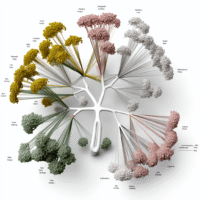AI Tech News
-
Scale Your Pandas Workflows with Modin: A Comprehensive Coding Guide for Data Professionals
Understanding the Target Audience The primary audience for this guide includes data scientists, data engineers, and analysts who are already familiar with Python and the Pandas library. These professionals typically work in sectors that demand extensive data manipulation and analysis, such as finance, e-commerce, and healthcare. Pain Points Performance bottlenecks when handling large datasets. Memory […] ➡️➡️➡️
-
Google AI Launches MedGemma 27B and MedSigLIP: Advancements in Open-Source Medical AI
The MedGemma Architecture MedGemma is a groundbreaking initiative that builds on the Gemma 3 transformer backbone, specifically tailored for the healthcare sector. This architecture is designed to tackle some of the most pressing challenges in clinical AI, such as data heterogeneity and the need for efficient real-world deployment. By integrating multimodal processing, MedGemma can handle […] ➡️➡️➡️
-
“Discover Comet: The AI-Powered Browser Revolutionizing Online Research”
A New Paradigm in Web Browsing Traditional web browsers have remained largely unchanged for years, primarily focusing on manual searches and passive information retrieval. However, Comet is here to disrupt that model. This innovative browser embeds a research assistant directly into the browsing experience, transforming how users navigate and interact with web content. Instead of […] ➡️➡️➡️
-
Salesforce AI’s GTA1: Revolutionary GUI Agent Surpassing OpenAI’s CUA
Introduction to GTA1 Salesforce AI Research has unveiled GTA1, a groundbreaking graphical user interface (GUI) agent that takes human-computer interaction to the next level. This innovative tool operates autonomously within real operating system environments, specifically targeting Linux. GTA1 successfully addresses two major challenges in GUI agent development: ambiguous task planning and inaccurate grounding of actions. […] ➡️➡️➡️
-
Master Prompt Engineering: Unlock AI Potential for Developers and Business Professionals
Understanding the Target Audience for Mastering Prompt Engineering The audience for “Master the Art of Prompt Engineering” primarily includes business professionals, software developers, and AI enthusiasts eager to enhance their skills in effectively utilizing AI models. While they are generally tech-savvy, many face challenges with the nuances of prompt engineering, a critical skill for optimizing […] ➡️➡️➡️
-
Microsoft Open-Sources GitHub Copilot Chat for Free VS Code Development
Microsoft’s decision to open-source the GitHub Copilot Chat extension for Visual Studio Code (VS Code) marks a pivotal shift in the landscape of AI-powered development tools. Now available for free under the MIT license, this previously premium tool enhances accessibility for all developers, allowing for greater customization and collaboration. Key Features of GitHub Copilot Chat […] ➡️➡️➡️
-
Hugging Face SmolLM3: The Cost-Effective 3B Multilingual Model for AI Developers and Businesses
Hugging Face has recently unveiled SmolLM3, a new language model designed to address the growing needs of AI developers, data scientists, and business managers. With its focus on efficiency and cost-effectiveness, SmolLM3 aims to provide a solution for those grappling with high operational costs and the need for multilingual capabilities. Overview of SmolLM3 SmolLM3 is […] ➡️➡️➡️
-
Anthropic’s Targeted Transparency Framework: A New Era for Frontier AI Regulation
Understanding Anthropic’s Targeted Transparency Framework As artificial intelligence (AI) technologies evolve rapidly, the discussion around safety, oversight, and risk management becomes crucial. In response to these challenges, Anthropic introduced a targeted transparency framework tailored for frontier AI systems. This proactive step addresses the need for meaningful oversight while promoting innovation among smaller developers. Why Choose […] ➡️➡️➡️
-
Google AI Releases Open-Source MCP Toolbox for Secure Database Integration with AI Agents
Understanding Google’s MCP Toolbox for Databases Google’s recent release of the MCP Toolbox for Databases is a game changer for integrating AI agents with SQL databases. This open-source module simplifies the process, allowing developers to connect AI models with databases like PostgreSQL and MySQL efficiently. But why is this important, and how does it work? […] ➡️➡️➡️
-
Build a Multi-Agent Workflow with Python and OpenAI for Enhanced Task Automation
Implementing a Tool-Enabled Multi-Agent Workflow with Python, OpenAI API, and PrimisAI Nexus Understanding the Target Audience This tutorial is designed for a diverse group of professionals, including data scientists, software engineers, project managers, and business analysts. Each of these roles faces unique challenges when it comes to integrating AI into their workflows. For instance, data […] ➡️➡️➡️
-
Revolutionizing Video Diffusion: How Radial Attention Cuts Costs by 4.4× While Enhancing Quality
Introduction to Video Diffusion Models and Computational Challenges Video diffusion models have revolutionized the way we generate and understand video content. They rely on complex algorithms, building on the foundation of image synthesis, to create high-quality videos. However, unlike static images, videos add an extra layer of complexity due to their temporal dimension, which greatly […] ➡️➡️➡️
-
Revolutionize Code Merging with Osmosis-Apply-1.7B: A Developer’s Guide
Introduction to Osmosis-Apply-1.7B Osmosis AI has introduced Osmosis-Apply-1.7B, a specialized model designed for efficient and accurate code merging. Unlike general-purpose language models, this fine-tuned variant of Qwen3-1.7B focuses on structured code edits, making it a valuable tool for developers. By utilizing a unique combination of code-specific formatting tags and a high-quality dataset, this model achieves […] ➡️➡️➡️
-
ByteDance Launches Trae Agent: Revolutionizing Software Engineering with LLMs
Understanding Trae Agent Trae Agent is an innovative software engineering tool developed by ByteDance, designed to assist developers in navigating the complexities of programming tasks. By leveraging large language models (LLMs), it acts as a virtual assistant that can handle a variety of software engineering challenges. This includes everything from debugging to writing production-quality code, […] ➡️➡️➡️
-
Build a Python Weather Agent Using Agent Communication Protocol (ACP)
Understanding Agent Communication Protocol (ACP) The Agent Communication Protocol (ACP) is a game-changer in the world of artificial intelligence. It provides a standardized way for AI agents, applications, and humans to communicate seamlessly. As AI systems often operate in silos, the lack of interoperability can hinder their effectiveness. ACP bridges this gap by offering a […] ➡️➡️➡️
-
Scalable Human-AI Alignment: Introducing SynPref-40M and Skywork-Reward-V2
Understanding Limitations of Current Reward Models Reward models play a crucial role in Reinforcement Learning from Human Feedback (RLHF). However, many leading open models struggle to capture the full spectrum of human preferences. Despite advancements in training techniques, progress remains limited. A significant factor is the inadequacy of current preference datasets, which are often too […] ➡️➡️➡️
-
Boosting LLM Alignment: Meta and NYU’s Semi-Online Reinforcement Learning Breakthrough
Understanding the Target Audience The research presented here is particularly relevant for AI researchers, data scientists, business managers, and decision-makers in technology firms. These individuals face challenges in aligning large language models (LLMs) with human expectations, optimizing model performance, and efficiently managing computational resources. Their primary goals include enhancing AI usability, improving model accuracy across […] ➡️➡️➡️
-
Mastering Context Engineering in AI: Techniques and Applications for Enhanced Model Performance
Context engineering is an emerging discipline that focuses on the design and organization of the context fed into large language models (LLMs) to optimize their performance. Unlike traditional methods that concentrate on fine-tuning model weights or architectures, context engineering prioritizes the input itself—how prompts, system instructions, and retrieved knowledge are structured. This practice is becoming […] ➡️➡️➡️
-
Build Intelligent Self-Correcting QA Systems with DSPy and Gemini 1.5
Building Modular and Self-Correcting QA Systems with DSPy In today’s fast-paced digital world, the ability to provide accurate and timely answers is crucial. This article explores how to create a modular and self-correcting question-answering (QA) system using the DSPy framework integrated with Google’s Gemini 1.5 Flash model. This system leverages structured Signatures, composable modules, and […] ➡️➡️➡️
-
Chai-2: Revolutionizing De Novo Antibody Design with 16% Hit Rate
Overview of Chai-2 The Chai Discovery Team has made a remarkable breakthrough with the launch of Chai-2, a multimodal AI model designed for zero-shot de novo antibody design. This innovative platform has achieved a 16% hit rate across 52 novel targets, significantly outperforming previous methods by over 100 times. What sets Chai-2 apart is its […] ➡️➡️➡️
-
Boosting LLM Robustness: Abstract Reasoning with AbstRaL for AI Researchers and Data Scientists
Understanding the Importance of Robustness in Language Models Large language models (LLMs) have transformed how we interact with technology, but they still face significant challenges, particularly in out-of-distribution (OOD) scenarios. These situations arise when models encounter data that differ from what they were trained on, leading to inaccuracies. For AI researchers, data scientists, and business […] ➡️➡️➡️


















